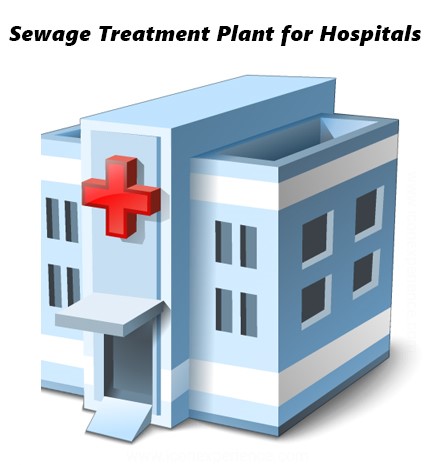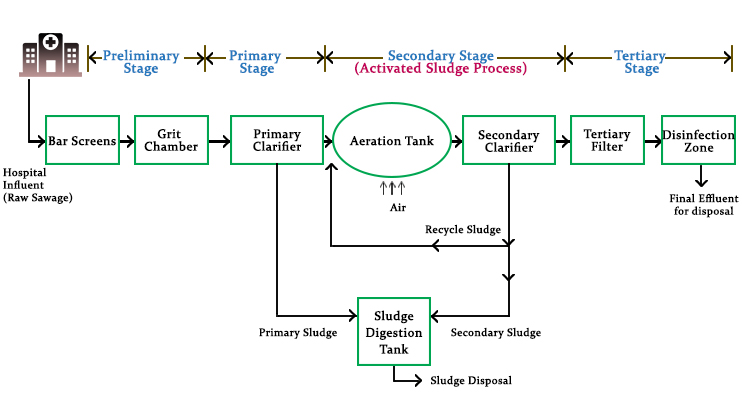Sewage Treatment Plant for Hospitals
Sewage Treatment Plant for Hospitals
Generally, wastewater is defined as the composition of physical, chemical and biological waste present in wastewater. Hospital sewage is a wastewater generated relatively in larger quantities from all the units of the hospitals such as emergency and first aid, operating rooms, drug treatment, ICU, chemical and biological laboratories, radiology, canteen and laundry activities etc.
Since, hospital sewage/wastewater consists of various potentially hazardous components that will cause many risks on human and environment by polluting surface and ground water. Hence, hospital sewage treatment is very much required.
The major objective of hospital wastewater treatment plant is to treat the influent (untreated wastewater) generated by the hospitals and healthcare sectors before its direct release into natural environment. Hospital wastewater may have an adverse impact on environments and human health. Therefore, proper wastewater management in each and every hospital is prerequisite.

Hospital Sewage Characteristics:
Wastewater from various hospitals consists of:
1. Microbial pathogens and harmful bacteria and virus
2. Pharmaceuticals and its metabolites
3. Radioactive isotopes
4. Hazardous chemicals, heavy metals
5. Drug residues
Conventional processes involved in Sewage Treatment Plant (STP) for Hospitals is shown below:

Sewage Treatment Process:
Compact or packaged sewage treatment plant for hospitals is done in series of steps.
1. Preliminary Stage or Pretreatment: As a first stage, the preliminary treatment process is essential in most sewage treatment plant (STP). It removes items such as sticks, rags, and other large debris and heavy inorganic solids contained in the hotel influent through bar screens. Removal of these materials protects the plant’s equipment from damage. The inorganic settled is called grit which is removed using a grit chamber.
2. Primary Treatment Stage: This is the second step in the sewage treatment system. Physical separation of solids and greases from wastewater is done in this stage. Now, water flows into the primary filter or clarifiers for a few hours to allow solid particles to settle down and lighter particles will float to the top and be skimmed off from the tank. The settled solid is called primary sludge or primary effluent and contains about 60-70% of solids. Partly treated wastewater is now subjected to the next treatment level.
3. Secondary Treatment Stage: It is a biological treatment process that removes dissolved inorganic materials present in soluble and colloidal form from the wastewater. Here, bacteria are used to convert the colloidal and dissolved organic matter. Now the partially treated wastewater from the primary tank flows into the aeration tank and air is supplied through an air blower to provide oxygen for microbes. When wastewater flows into a secondary clarifier, solids settle down which is called secondary sludge, and part of it is recycled for the activated sludge process, and the remaining is mixed with primary sludge which will be sent to the sludge digestion tank and then disposed off. This stage removes about 90% of inorganic solids.
4. Tertiary or Advanced Treatment Stage: This is the last stage in most of the STPs. This stage removes the suspended solids and organic matter which was not removed in secondary treatment. The pathogenic microorganisms that were not removed during the biological treatment process will be removed by a process called disinfection. Several disinfection agents can be used depending on wastewater conditions (pH, clarity, etc). It is achieved using physical or chemical disinfectants like chlorine, UV light, ozone, etc. Now, disinfected wastewater is suitable for disposal or reuse.
If the water is not treated adequately, the harmful contaminants in the sewage are hazardous to human health and the natural environment. So, Sewage Treatment Plant in hospitals is always necessary to reduce harmful impact on the environment.
Sewage treatment plants play a crucial role in safeguarding public health by ensuring a reliable supply of clean and safe drinking water, as well as protecting the environment by treating and returning wastewater responsibly.
Sintech Engineering Solutions is an Importer and manufacturer of Water Treatment Plant (WTP) in Bangladesh.
Email: sales@sintechbd.com; Cell: 01829-675191
